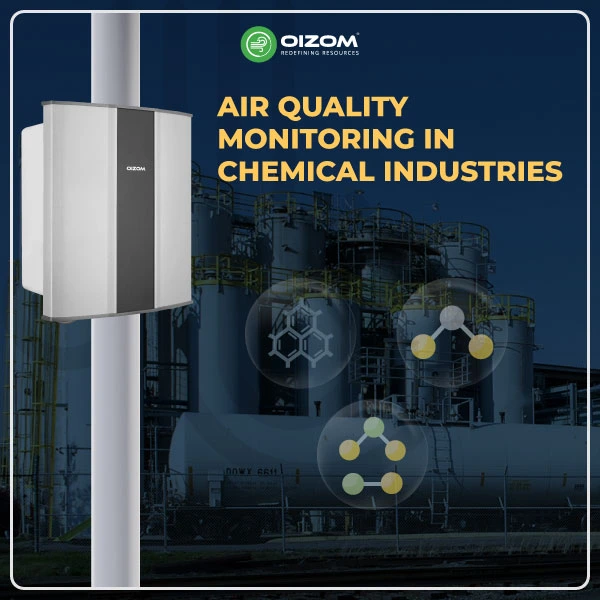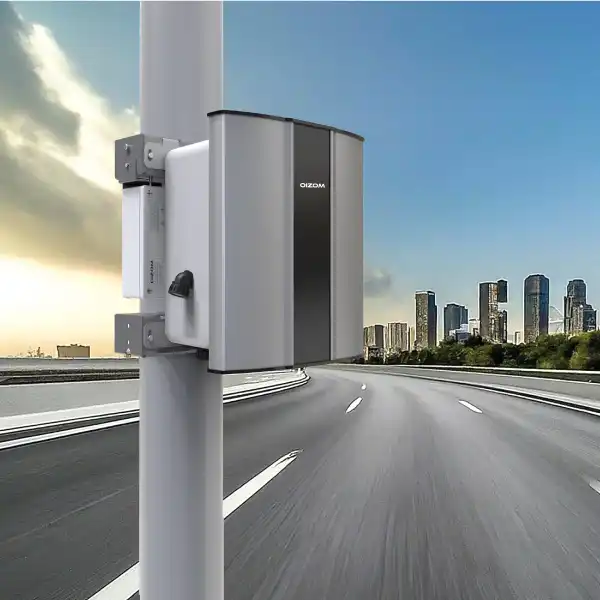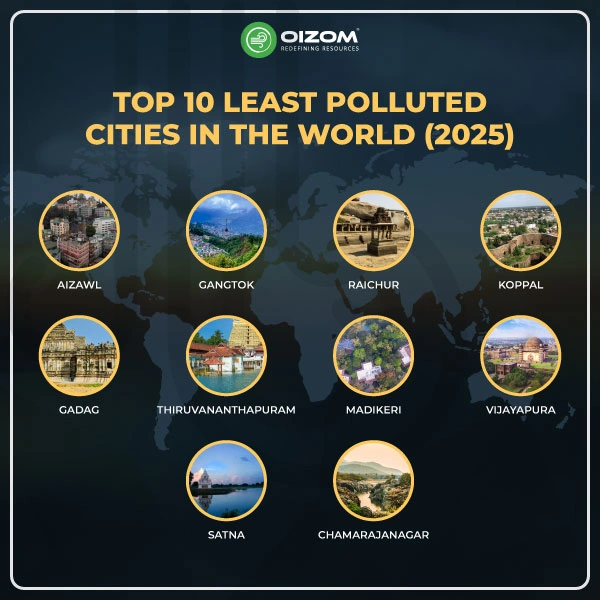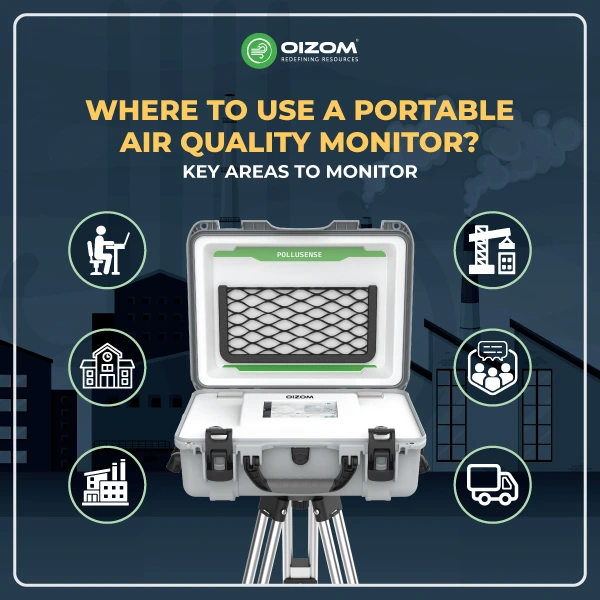Summary
Air pollution in the chemical industry is not just an environmental risk. It directly threatens worker health, regulatory compliance, and operational efficiency. Key pollutants include VOCs, PM, SO₂, NOx, CO, NH₃, and H₂S, originating from stacks, leaks, combustion, and storage areas.
To address these risks, industries are shifting from periodic sampling to real-time monitoring using technologies like CEMS for stack emissions and ambient IoT sensors for on-site and boundary monitoring. Devices like Oizom’s Polludrone and Odosense help detect and act on pollutant spikes instantly, with cloud-based platforms like Envizom offering visualizations, alerts, and reports.
Integration with pollution control devices, scrubbers, filters, and oxidizers ensures that not only are emissions monitored, but also effectively managed. With AI/ML, predictive analytics now helps prevent violations before they happen.
In short, clean air in chemical plants starts with smart monitoring, ensuring safety, sustainability, and compliance.
Air Quality Monitoring in Chemical Industries
Air quality in the chemical industry isn’t just a regulatory checkbox. It’s a vital part of protecting worker health, ensuring process efficiency, and staying environmentally responsible.
Chemical plants often handle combustion, solvent use, material transfer, and waste processing, all of which release harmful pollutants like VOCs, SO₂, NOx, CO, and fine particulate matter. These emissions can impact not only onsite teams but also surrounding communities and the environment.
That’s why real-time air quality monitoring has become essential. It’s no longer enough to measure periodically or rely on manual logs. Industries today need smart, continuous systems that offer visibility, accountability, and actionable insights.
If you’re an EHS manager, you’re likely focused on compliance and early warning systems. If you’re from the industry side, you’re probably exploring the right technologies to future-proof operations. And if you’re a PhD student or researcher, understanding the key aspects of pollutants and monitoring tools is key to meaningful studies and innovation.
In this blog, we’ll explore:
- What pollutants matter most in chemical operations
- The technologies available (CEMS, ambient monitors, IoT sensors)
- How data supports regulatory compliance, health, and sustainability
Let’s unpack the science, systems, and strategy behind air quality monitoring in chemical industries.
Understanding Air Pollution in the Chemical Sector
Chemical industries are a major source of complex air pollutants, many of which are harmful even at low concentrations. Understanding what’s in the air is the first step toward controlling it.
Common Air Pollutants in Chemical Processes
Volatile Organic Compounds (VOCs) are one of the most common emissions in chemical manufacturing. Released during solvent use, cleaning, and storage processes, VOCs like benzene, toluene, and xylene can cause respiratory issues, headaches, and even long-term neurological effects.
Particulate Matter (PM1, PM2.5, PM10) is often generated from combustion, drying, and material handling. These fine particles can penetrate deep into the lungs and bloodstream, increasing the risk of heart and lung diseases.
Gaseous pollutants such as sulfur dioxide (SO₂), nitrogen oxides (NOx), carbon monoxide (CO), ammonia (NH₃), and hydrogen sulfide (H₂S) are also widely present. These gases originate from reactions, flue gases, and storage leaks and contribute to acid rain, smog, and worker exposure risks.
Sources of Emissions
In a chemical facility, air pollution doesn’t come from just one place; it’s the result of multiple, often overlooked sources.
Stack emissions come from activities like burning fuel, heating materials, or processing chemicals in industrial plants. The gases released through tall stacks or chimneys can contain a mix of air pollutants, depending on the fuel used and how the process is run.
Some of the most common pollutants found in stack emissions include:
- Particulate Matter (PM)
- Sulfur Dioxide (SO₂)
- Nitrogen Oxides (NOₓ)
- Carbon Monoxide (CO)
- Carbon Dioxide (CO₂)
- Volatile Organic Compounds (VOCs)
Each of these pollutants poses specific risks. Particulate matter can enter deep into the lungs and cause breathing problems. SO₂ and NOₓ are major contributors to acid rain and urban smog. Carbon monoxide is a poisonous gas that can be deadly at high levels. While CO₂ doesn’t harm health directly, it’s a leading cause of global warming. VOCs can also affect both indoor and outdoor air quality, leading to long-term health concerns.
Understanding what comes out of industrial stacks is key to controlling pollution, protecting workers, and reducing environmental damage.
Fugitive leaks are harder to detect but just as dangerous. These come from valves, pumps, flanges, and joints where chemicals escape unintentionally, often without immediate notice.
Combustion systems used in boilers, heaters, and incinerators release a mix of particulates and gases, especially when operating under suboptimal conditions.
Storage and material handling, whether it’s transferring solvents or storing raw materials, can also result in vapor losses, especially when tanks aren’t sealed properly or during high-temperature operations.
Health, Safety, and Environmental Impact
Air pollutants from chemical industries don’t just impact the air; they impact people, productivity, and the planet.
Worker exposure to VOCs, PM, and toxic gases can lead to respiratory problems, skin irritation, neurological disorders, and in some cases, long-term illnesses like cancer.
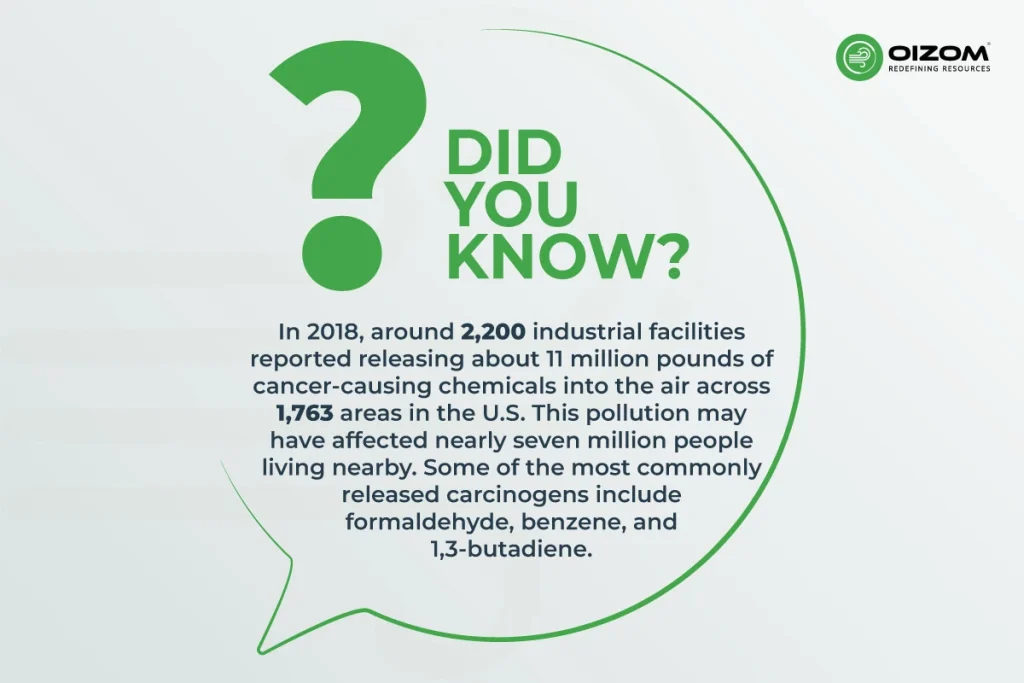
Environmental degradation follows, with pollutants contributing to smog, acid rain, and soil and water contamination, especially near discharge points or poorly ventilated zones.
There are also legal and financial consequences. Regulatory violations can lead to hefty fines, plant shutdowns, or litigation. More importantly, a lack of proper monitoring can damage an organization’s reputation and stakeholder trust. Recently, a report by B&K Research highlighted that the chemical industry expects a slow recovery by 2025 due to economic pressure and operational challenges. In such a fragile landscape, non-compliance can be costly, with regulatory bodies like CPCB issuing shutdown notices to multiple facilities across India.
Investing in continuous monitoring and early warning systems helps safeguard workers, maintain compliance, and protect surrounding ecosystems, all while improving operational efficiency.
Key Air Quality Parameters to Monitor
To effectively manage air quality in the chemical industry, it’s essential to monitor the right set of pollutants. These parameters help identify risks to worker health, environmental impact, and regulatory compliance. Here’s a breakdown of the most critical ones:

Particulate Pollutants
Particulate matter is more than just dust in the air, and it includes solid and liquid particles suspended during material handling, combustion, or chemical reactions. This can range from PM1, PM2.5, and PM10 to chemical mists and aerosols.
- Dust from grinding or transport processes
- Aerosols formed during spray drying or reactions
- Chemical mists from acid baths or mixing tanks
These particles can enter the respiratory system, with fine particulates (PM2.5 and below) reaching deep into the lungs and bloodstream, causing long-term health issues. Continuous monitoring helps ensure concentrations remain within safe occupational limits.
Gaseous Pollutants
Gaseous emissions are common byproducts in chemical plants and must be tracked carefully:
- NOx (Nitrogen Oxides): Produced during high-temperature combustion, contributing to smog and respiratory problems.
- SO₂ (Sulfur Dioxide): Released from burning sulfur-containing fuels; causes acid rain.
- CO (Carbon Monoxide): A colorless, odorless, toxic gas formed from incomplete combustion.
- O₃ (Ozone): Can form secondarily from NOx and VOCs under sunlight; irritates lungs and eyes.
- NH₃ (Ammonia) and H₂S (Hydrogen Sulfide): Common in fertilizer and petrochemical sectors; both can be hazardous at low levels.
Monitoring these gases is crucial for safety and helps in meeting OSHA, CPCB, and EPA air quality standards.
VOCs and Hazardous Air Pollutants (HAPs)
Volatile Organic Compounds (VOCs) and HAPs are particularly important in chemical manufacturing due to their toxicity and persistence in the atmosphere.
- Benzene, Toluene, Xylene, Formaldehyde: Widely used or formed as byproducts; all are known carcinogens or central nervous system irritants
VOCs can evaporate even at room temperature and contribute to ground-level ozone and indoor air contamination. Their measurement requires PID-based sensors or advanced sampling tools to detect even low concentrations accurately.
If you work with BTEX compounds, that’s benzene, toluene, ethylbenzene, and xylene, you already know how critical it is to keep a close eye on them. These volatile organics are commonly found in industrial emissions and, if not monitored properly, can pose serious risks to both human health and the environment.
To make monitoring easier and more reliable, Oizom now offers a dedicated BTEX sensor integrated into its environmental monitoring devices. With real-time data tracking and a modular design, these devices help industries and researchers detect BTEX levels with precision.
Whether you’re managing emissions or studying ambient air quality, Oizom’s BTEX monitoring solution gives you the data you need to act fast and stay compliant.
Technologies for Air Quality Monitoring in Chemical Plants
In a chemical plant, the right air quality monitoring technology isn’t just about compliance. It’s about gaining clarity, control, and confidence. As emission standards tighten and public scrutiny grows, industries need tools that offer precision and real-time visibility. Let’s explore the key technologies that are making that possible.
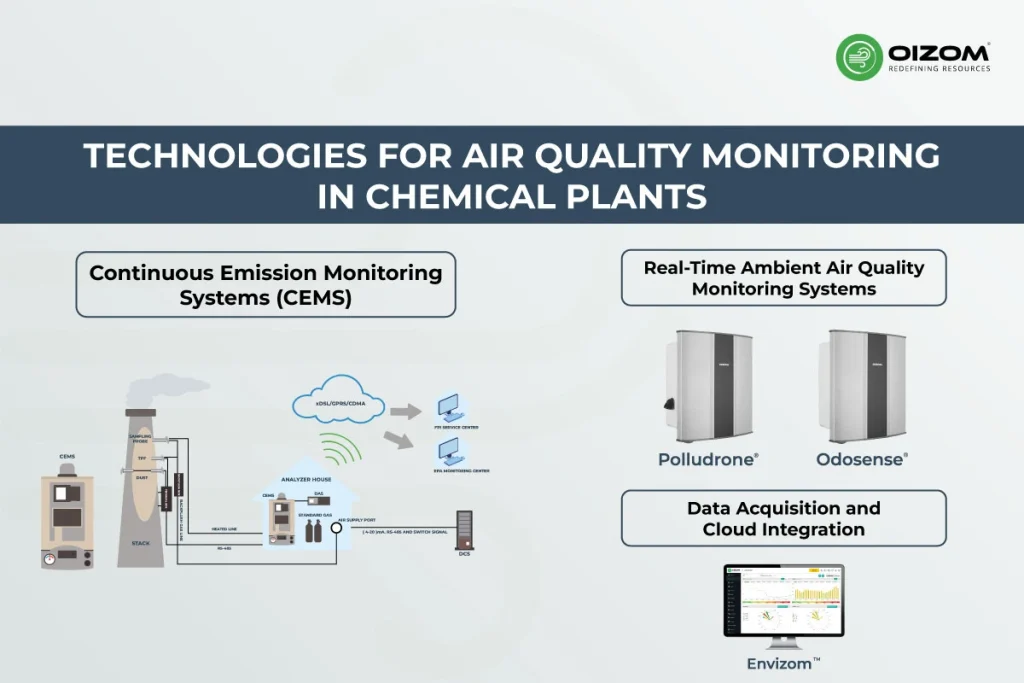
Continuous Emission Monitoring Systems (CEMS)
In the chemical industry, keeping a close eye on emissions is crucial, not just for compliance but for environmental responsibility. That’s where Continuous Emission Monitoring Systems (CEMS) come into play. These systems provide real-time data on pollutants released from industrial stacks, ensuring that emissions stay within permissible limits.
What Does CEMS Monitor?
CEMS are designed to continuously measure key pollutants such as:
- Sulfur Dioxide (SO₂)
- Nitrogen Oxides (NOₓ)
- Carbon Monoxide (CO)
- Carbon Dioxide (CO₂)
- Particulate Matter (PM)
- Volatile Organic Compounds (VOCs)
By providing continuous data, CEMS helps industries detect any deviations promptly, allowing for immediate corrective actions.
Importance of Calibration and Maintenance
Accurate readings are essential. Regular calibration, either automatic or manual, is vital to ensure the system’s precision. According to the CPCB guidelines industries must adhere to strict calibration protocols to validate the quality of data produced by CEMS. This ensures that the measurements are reliable and meet regulatory standards.
Regulatory Compliance and Reporting
CEMS data isn’t just for internal monitoring; it’s a critical component of regulatory compliance. In India, the CPCB mandates the use of CEMS in various sectors to monitor emissions continuously. The data collected aids in:
- Demonstrating compliance with environmental standards.
- Generating alarms for exceedances, facilitating prompt responses.
- Providing transparent records for regulatory bodies.
Integration with Data Systems
Modern CEMS are often integrated with Data Acquisition and Handling Systems (DAHS), allowing for seamless data collection, storage, and reporting. This integration ensures that industries can maintain comprehensive records and easily share data with authorities when required.
Core Technologies Used in CEMS
CEMS isn’t a single device; it’s a combination of sensors and analyzers, chosen based on the pollutant type and measurement requirement:
- NDIR (Non-Dispersive Infrared) – For CO, CO₂, and SO₂
- UV-DOAS (Ultraviolet Differential Optical Absorption Spectroscopy) – For SO₂, NOx, and O₃
- FTIR (Fourier Transform Infrared) – For multi-gas analysis, including VOCs
- Electrochemical Sensors – For gases like CO and O₂ (typically in low concentrations)
- Opacity Monitors / Triboelectric Sensors – For measuring PM in stack gas
- Paramagnetic and Zirconia Sensors – For O₂ analysis
Each technology has its own use case, accuracy range, and maintenance requirement.
Real-Time Ambient Air Quality Monitoring Systems
While CEMS focuses on emissions directly from stacks and chimneys, ambient air quality monitoring systems are designed to measure the quality of air in and around industrial sites. These systems help detect pollution as it disperses into the environment, offering a broader picture of air quality impacts on workers, nearby communities, and ecosystems.
These sensor-based systems continuously monitor pollutants like:
- Particulate Matter (PM1, PM2.5, PM10)
- Volatile Organic Compounds (VOCs)
- Gaseous pollutants such as O₃, NH₃, H₂S, NO₂, SO₂, and CO
They use electrochemical sensors for toxic gases, optical particle counters for PM, and PID (Photoionization Detectors) for VOC detection. The data is collected in real time, helping environmental teams quickly respond to pollution spikes, track trends, and ensure regulatory compliance.
These systems are especially useful for:
- Boundary monitoring around chemical plants
- Worker exposure assessments
- Short-term audits or environmental studies
Oizom’s Real-Time Monitoring Solutions
Oizom offers cutting-edge ambient monitoring systems tailored for industrial applications:
Polludrone
Polludrone is a comprehensive ambient air quality monitoring system that measures a wide range of pollutants, including PM1, PM2.5, PM10, SO₂, NO₂, O₃, CO, and more. It’s ideal for fixed installations around plant perimeters or urban-industrial interfaces. With real-time data access and automated reporting through the Envizom platform, Polludrone enables proactive environmental management and helps meet CPCB and international standards.
Want to see how Polludrone Pro works on the ground? Here’s a quick look. Reliance Chemical Products Ltd. needed a reliable way to monitor air quality around their facility. They chose Polludrone Pro to measure pollutants and weather conditions in real time. Using Envizom, their team could easily view the data, spot any changes, and act quickly. This helped them improve safety, stay compliant, and run their operations more smoothly. Read the full case study to see how they did it.
Odosense – Odour Monitoring for Chemical Industries
In chemical plants, odour isn’t just unpleasant, it signals potential gas leaks and regulatory risk. Oizom’s Odosense offers real-time monitoring of VOCs, H₂S, NH₃, CH₄, and other odour-causing gases commonly released during reactions, solvent use, and waste handling.
Built for extreme industrial environments, Odosense uses PID and electrochemical sensors to detect low-level gas concentrations with high sensitivity. It’s ideal for boundary monitoring, leak detection, and community impact assessment. To ensure data accuracy, Odosense supports routine calibration using reference gases, aligning with industry best practices and compliance needs.
With cloud connectivity via Envizom, users get instant alerts, odour trend insights, and automated reports, helping chemical industries act fast, stay compliant, and maintain community trust.
Did you know that what sets Odosense apart is its 3-level calibration process, which includes factory calibration, multi-span calibration, and collocation calibration, all aligned with U.S. EPA guidelines. This ensures highly accurate and reliable data, which is crucial for maintaining compliance and addressing community concerns.
With real-time monitoring, plant operators can take timely action to mitigate odour and emissions before they escalate into bigger problems.
Want to see Odosense in action? Here’s how one of the world’s leading chemical manufacturers put it to work.
At the Mitsubishi Chemical Plant in the USA, managing odour emissions was a key priority. By installing Odosense, they gained round-the-clock monitoring of ambient odour levels.
But what really helped them act on the data was Envizom, Oizom’s air quality monitoring software. It enabled the team to interpret trends, track fluctuations, and respond quickly, ensuring better control and regulatory compliance. It’s a great example of real-time monitoring in action. Read the full case study to see how data turned into decisions.
Data Acquisition and Cloud Integration
Air quality monitoring doesn’t stop at measurement; it’s what you do with the data that makes the real impact. That’s why data acquisition systems with cloud integration are a critical part of modern air monitoring setups, especially in complex environments like chemical plants.
These systems automatically collect, store, and transmit environmental data from sensors in real time. Whether it’s PM, VOCs, or toxic gases, the data is pushed securely to the cloud, making it accessible through intuitive web dashboards or mobile apps. This enables remote monitoring, so EHS managers and plant operators can track air quality from anywhere, without waiting for manual logs or physical inspections.
More importantly, built-in alert systems notify users immediately when pollutant levels exceed safe or legal thresholds. These instant notifications help teams take timely action, reducing health risks and preventing compliance breaches.
To simplify this process, advanced platforms like Oizom’s Envizom offer a complete solution, allowing users to visualize data trends, generate automated reports, and manage compliance records from a single, user-friendly interface. It’s a smart way to reduce manual errors, save time, and stay on top of your air quality goals, whether you’re operating a large chemical facility or managing multiple sites.
Regulatory Framework and Compliance
In the chemical industry, air quality monitoring isn’t just a best practice. It’s a regulatory requirement. Failing to comply can lead to heavy penalties, operational disruptions, and reputational damage. That’s why understanding the regulatory landscape is key to building an effective air quality strategy.
Global and Regional Guidelines
Different regions have their own compliance frameworks, but the goal is the same: to limit exposure to harmful pollutants and ensure a safer environment.
- CPCB (India) mandates Continuous Emission Monitoring Systems (CEMS) for specific industries, including chemicals, to report real-time emission data to pollution control boards.
- USEPA (United States) outlines strict emission limits under the Clean Air Act, requiring ambient and stack monitoring for pollutants like NOx, SO₂, VOCs, and PM.
- EU Directives regulate industrial emissions under the Industrial Emissions Directive (IED), focusing on best available techniques (BAT).
- OSHA (US) sets occupational exposure limits to ensure that indoor air quality doesn’t compromise worker health, particularly in enclosed chemical manufacturing areas.
Staying updated with these standards is essential for operating legally and ethically in global supply chains.
Industry Compliance Challenges
Compliance isn’t always straightforward. Many facilities still rely on legacy systems that lack real-time capabilities or automated reporting. This makes it harder to meet current monitoring and documentation requirements.
There’s also the cost factor; installing monitoring systems and maintaining them can seem expensive upfront. But the cost of inaction, including fines, shutdowns, and public backlash, can be far greater, both financially and operationally.
Role of EHS Officers and Auditors
EHS officers play a frontline role in managing compliance. From setting internal air quality thresholds to overseeing real-time monitoring, their work is vital for early detection and risk reduction.
Environmental auditors ensure that the data being reported is accurate, validated, and in line with regulations. They also guide corrective actions and support third-party certifications, key for client trust and regulatory transparency.
Data-Driven Decision Making for Air Quality
Air quality monitoring isn’t just about collecting data; it’s about using that data to make smarter, faster decisions. In today’s chemical industry, real-time insights are key to staying compliant, optimizing operations, and ensuring a safer environment for workers and surrounding communities.
Using Environmental Intelligence
Thanks to advancements in AI and machine learning (ML), industries can now move beyond basic monitoring. These technologies analyze historical and real-time air quality data to identify emission patterns, detect anomalies, and even predict potential exceedances before they happen.
For instance, AI models can flag recurring VOC spikes near a storage unit, suggesting possible leaks or inefficiencies. Similarly, ML algorithms can forecast emission trends based on production schedules, weather data, and equipment cycles, helping EHS teams act proactively rather than reactively.
This level of predictive intelligence is critical in high-risk environments like chemical plants, where even a small delay in response can lead to regulatory violations or safety incidents.
Dashboards and Analytics Platforms
To make sense of all this data, user-friendly dashboards and analytics platforms are essential. These tools consolidate sensor inputs and display key metrics in real time, including PM levels, VOC concentrations, gas thresholds, and more, all in one place.
With customizable dashboards, EHS officers can monitor KPIs such as average emissions per process, frequency of threshold breaches, and time-to-response for alerts. This empowers teams to track performance, fine-tune pollution control systems, and demonstrate compliance with minimal manual effort.
Modern platforms also offer automated reporting, trend analysis, and role-based access, ensuring that the right people get the right data at the right time.
Best Practices for Pollution Control Devices
Monitoring air quality is only half the equation; controlling emissions effectively is the other. In chemical industries, where gases, vapors, and fine particulates are frequently released, integrating monitoring systems with pollution control devices is essential for reducing environmental and health risks.
Integration with Pollution Control Devices
Scrubbers: Wet scrubbers are commonly used to remove gaseous pollutants like SO₂ and HCl from exhaust streams. By bringing the polluted gas into contact with a scrubbing liquid, these devices effectively absorb and neutralize contaminants. Integrating scrubbers with real-time monitoring systems allows for continuous assessment of their efficiency, ensuring emissions remain within permissible limits.
Filters: Particulate filters, such as baghouse filters and electrostatic precipitators, are employed to capture fine particulate matter (PM) from exhaust gases. Regular maintenance and integration with monitoring equipment ensure that filters operate at peak efficiency, preventing potential blockages and ensuring consistent air quality.
Oxidation Systems: Thermal and catalytic oxidizers are used to decompose volatile organic compounds (VOCs) and other hazardous air pollutants into less harmful substances through high-temperature combustion processes. By integrating these systems with continuous emission monitoring, facilities can optimize operating conditions to maximize destruction efficiency and minimize secondary pollutant formation.
Integrating these pollution control devices with advanced monitoring and data acquisition systems enables chemical industries to maintain compliance with environmental regulations, optimize operational efficiency, and demonstrate a commitment to environmental stewardship.
Conclusion
Air quality monitoring in the chemical industry isn’t just about following the rules; it’s about creating a safer workplace, protecting the environment, and running smarter operations.
From stack emissions to ambient air and odour levels, today’s chemical plants need real-time data to catch problems early and stay compliant. Tools like CEMS, ambient air monitors, and cloud-based platforms give teams the insights they need to act fast and improve air quality.
When these systems are connected to pollution control devices, like scrubbers, filters, and oxidizers, they help ensure that emissions stay under control and that equipment is working as expected.
Looking to the future, we’ll see even more advanced solutions. AI and machine learning will help predict when emissions might spike, and smart alerts will make it easier to respond before issues happen. With IoT and automation, managing air quality will become more efficient and less manual.
Whether you’re managing compliance, optimizing plant performance, or conducting research, one thing is clear: clean air starts with smart monitoring. And staying ahead today means building a healthier tomorrow for people, the industry, and the planet.
FAQs
VOCs, PM1/2.5/10, SO₂, NOx, CO, NH₃, H₂S, and O₃ are frequently emitted from stacks, leaks, and material handling.
Real-time monitoring enables instant alerts, faster responses, and continuous data, unlike manual sampling, which is periodic and may miss peak exposures.
Continuous Emission Monitoring Systems (CEMS) track pollutants from stacks 24/7 to ensure regulatory compliance and optimize combustion processes.
Yes. With AI and trend analytics, monitoring systems can detect early signs of leaks, filter clogging, or abnormal emissions, helping prevent costly breakdowns.
Devices like Polludrone and Odosense monitor critical pollutants with high accuracy and send automated reports through Envizom to help meet CPCB, EPA, and OSHA guidelines.

